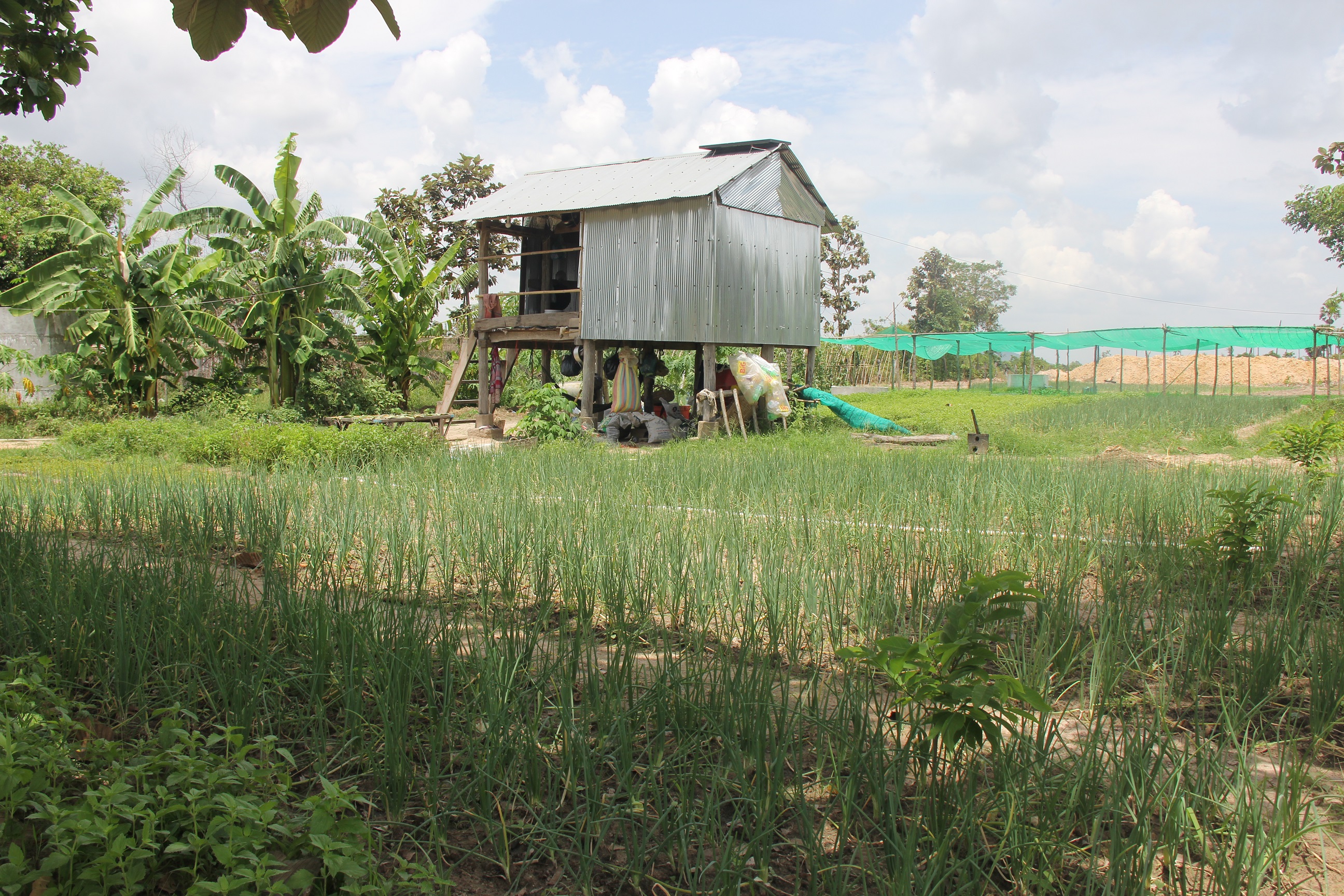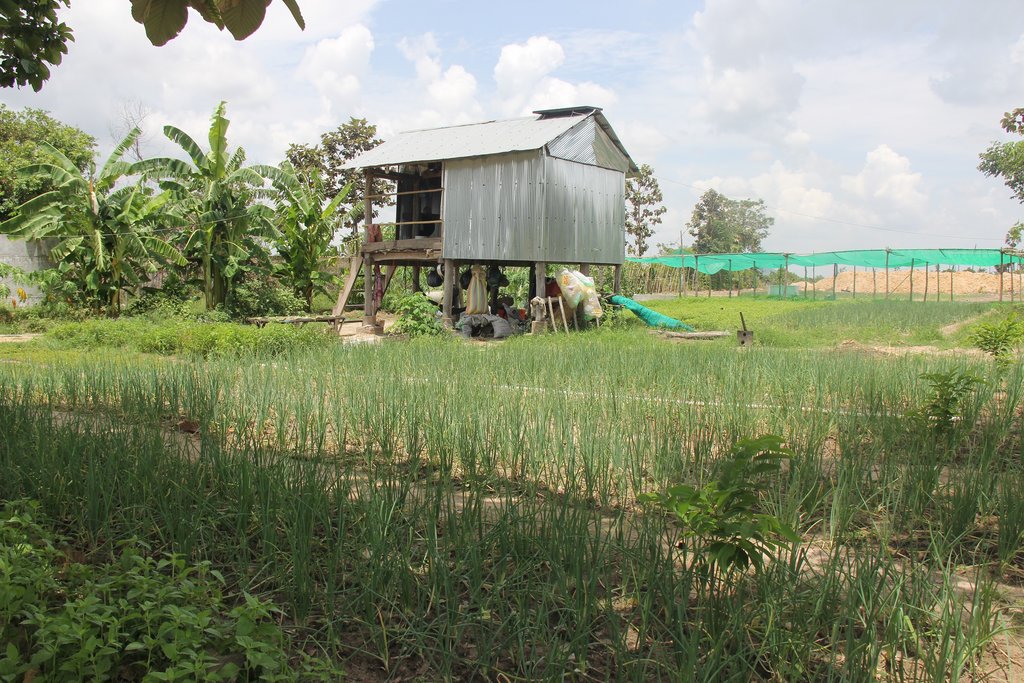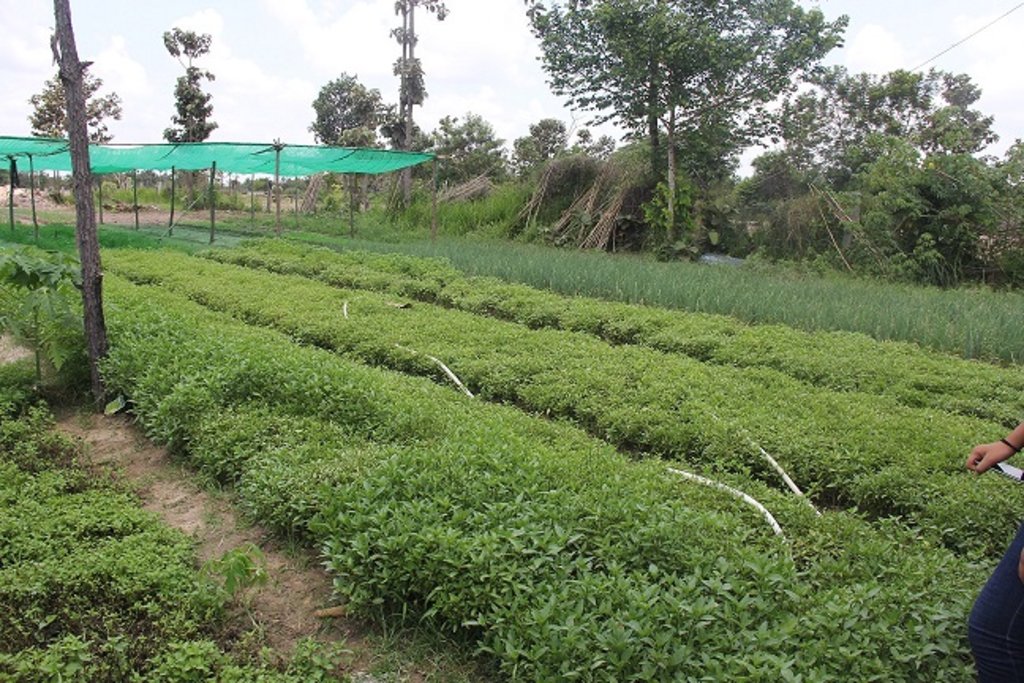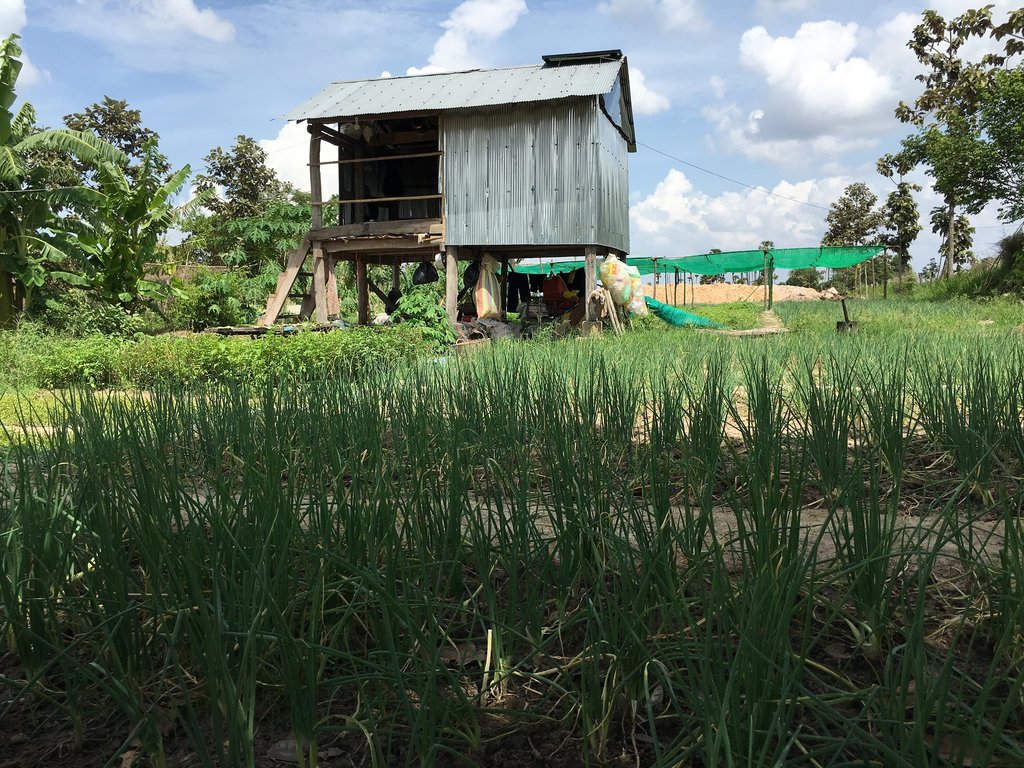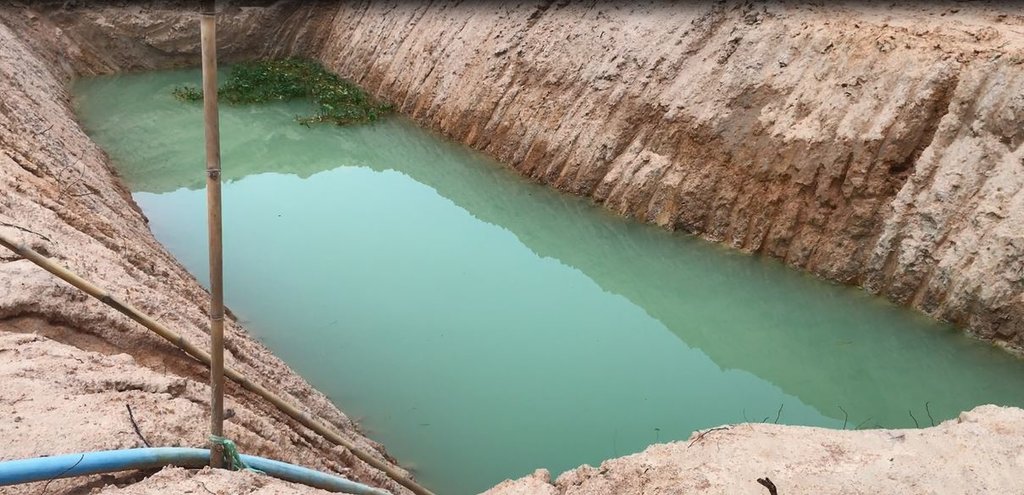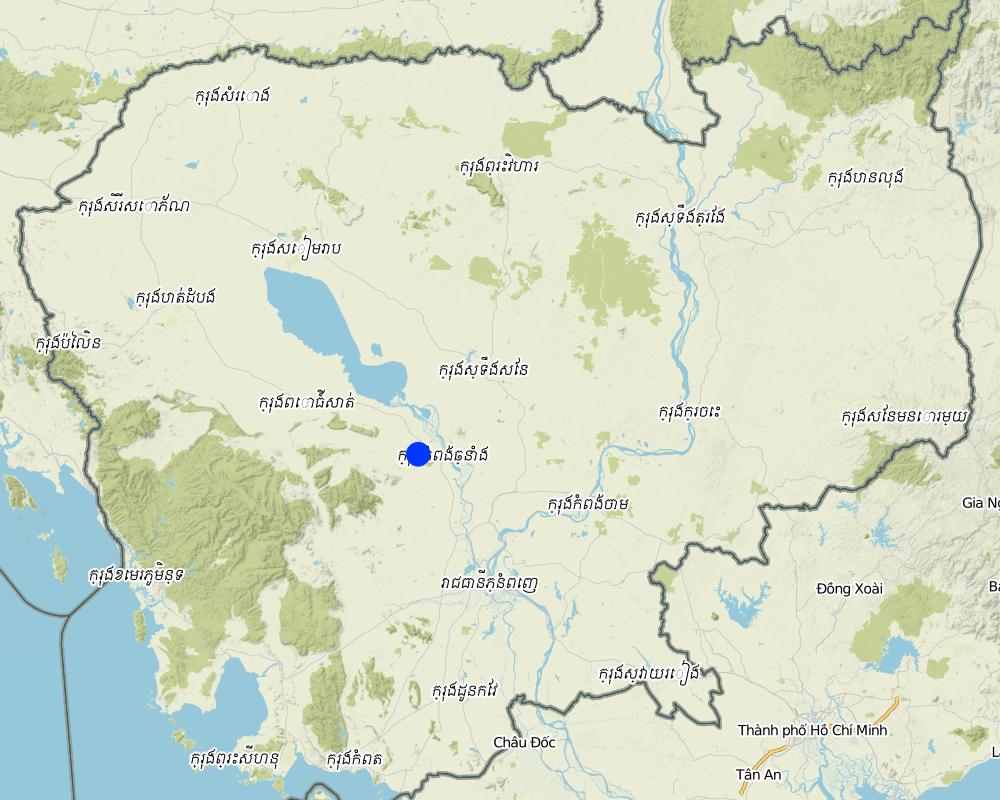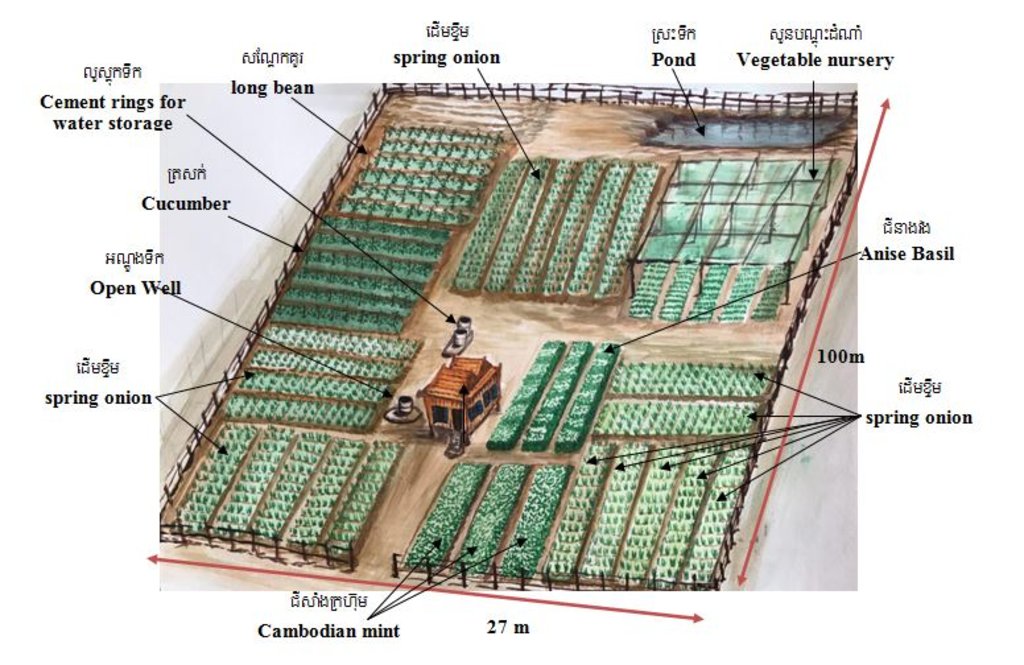Crop diversification with the application of rotation techniques [柬埔寨]
- 创建:
- 更新:
- 编制者: Navin Chea
- 编辑者: Sophea Tim, Sok Pheak
- 审查者: Nimul CHUN, Ursula Gaemperli
Crop diversification farm
technologies_3145 - 柬埔寨
查看章节
全部展开 全部收起1. 一般信息
1.2 参与该技术评估和文件编制的资源人员和机构的联系方式
关键资源人
土地使用者:
Phrum Thon
(+855) 95 211 223 / (+855) 69 40 6550
N/A
Land User
Ruessei Duoch village, Banteay Peal Commune, Rolea B'ier District, Kampong Chhnang Province.
柬埔寨
Vice Chief of Agronomy Office at Agricultural Office of Rolea B'ier :
Chhim Bunleang
(+855) 77 797324
chhimbunleang@gmail.com
Agricultural Office of Rolea B'ier.
Prey Puoch village, Chrey Bak commune, Rolea B'ier district, Kampong Chhnange province.
柬埔寨
Vice Chief of Agricultural Extension Office at Provincial Department of Agriculture, Forestry and Fisheries, Kampong Chhnang province:
Chief of Agricultural Office of Tuek Phos:
有助于对技术进行记录/评估的项目名称(如相关)
Scaling-up SLM practices by smallholder farmers (IFAD)有助于对技术进行记录/评估的机构名称(如相关)
Royal University of Agriculture (RUA) - 柬埔寨1.3 关于使用通过WOCAT记录的数据的条件
(现场)数据是什么时候汇编的?:
22/05/2017
编制者和关键资源人员接受有关使用通过WOCAT记录数据的条件。:
是
1.4 所述技术的可持续性声明
这里所描述的技术在土地退化方面是否存在问题,导致无法被认为是一种可持续的土地管理技术?:
否
2. SLM技术的说明
2.1 技术简介
技术定义:
Crop diversification is the practice of simultaneously cultivating two or multiple varieties of crops in a given area whilst at the same time applying crop rotation and/or intercropping. In this case study the land user has been practicing crop diversification with eleven different crop varieties.
2.2 技术的详细说明
说明:
Crop diversification entails simultaneously growing two or multiple varieties of crops in a particular place with the application of crop rotation techniques and/or intercropping. The selection of the crop varieties will depend on the purpose of the land user. In general, a diversity of crops will provide a range of benefits such as food security, nutritional diversity, income generation, soil conservation, pest and disease control as well as adaptation to climate change (CGIAR, 2017, Makate et al, 2016, MoEYS& VVOB Cambodia, 2013).
Mrs. Prum Thon has been cultivating a diversity of crops with the application of rotation techniquesfor about 10 years, which involves exchanging an entire crop in a particular row. This means that cultivation can take place throughout the year without having to leave the land fallow. At the time of the interview eleven different crops had been cultivated including spring onions, anise basil, Cambodian mint, bok choy, choy sum, escarole, mint, long beans, cucumbers, bitter melons and lettuce. Almost all of these crops have an average lifespan of three months, except for the anise basil which can grow for one or two years depending on the way it is cultivated. After she has harvested a particular crop, she will then rotate this crop row with a new distinctive crop species. For instance after having harvested spring onions she will then plant mint in that row, and in the row where she was previously growing mint, she will rotate that with either spring onions or cucumbers.
The practice of crop diversification whilst at the same time rotating the crop in each of the rows aims to achieve the following main objectives:
Crop diversification enables the farmer to generate a daily income to offset her daily expenses which thereby becomes a means of improving her livelihood. Growing a diversity of crops can also enable her to meet a variety of market demands and generate a high daily income. If a farmer grows only one crop specie she can usually earn about 15,000 Riel per day, but if she plants four crop species such as anise basil, bok choy, long beans and cucumbers she can increase her income to about 20,000 Riel per day, However if she grows one more specie such as lettuce or grows eleven different crops, she would be able to increase her income up to 40,000 or 80,000 Riel per day. The practice of crop diversification enables her to generate an income on a daily basis.
Crop diversification with the rotation of the crop in each row after the harvest could assist in reducing soil degradation. According to her experience and observations each crop absorbs different nutrients from the soil. If one row is repeatedly used to cultivate spring onions, they tend not to flourish so well and the roots have a tendency to decay. However if they are rotated with another crop and the spring onions are then grown in another row, they are able to thrive and the roots and stems are less likely to spoil. Crop diversification also has other functions as the cover crops help to reduce soil degradation through expose to sunlight, maintain soil moisture, make the soil less compact and add beneficial micro-organisms to the soil. In addition crop diversification can control pests especially the practice of growing companion plants such as herbs or spring onions as this can prevent crops from being damaged by pests.
The use of this technology assists in improving livelihoods, reduces migration because she does not need to move in order to find a job in another location, and enables her to generate a daily income. In addition this technology is able to reduce the risk of crop failure resulting from damage by pests and insects.Furthermore it reduces the risks associated with changes in market demand as the farmer produces a diversity of crops and also it prevents and reduces soil degradation. In order to effectively use this technology there needs to be sufficient water supply such as a river, stream, well or pond.This enables the land user to grow crops throughout the year round and reduces damage of crops as the result of unpredictable adverse climate conditions such as changes in rainfall, or the occurrence of drought.
2.3 技术照片
2.5 已应用该技术的、本评估所涵盖的国家/地区/地点
国家:
柬埔寨
区域/州/省:
Ruessei Duoch village, Banteay Peal Commune, Rolea B'ier District, Kampong Chhnang Province.
Map
×2.6 实施日期
如果不知道确切的年份,请说明大概的日期:
- 10-50年前
2.7 技术介绍
详细说明该技术是如何引入的:
- 通过土地使用者的创新
- 在实验/研究期间
- 通过项目/外部干预
注释(项目类型等):
Through her experience and training from Cambodian Center for Study and Development in Agriculture (CEDAC).
3. SLM技术的分类
3.1 该技术的主要目的
- 改良生产
- 减少、预防、恢复土地退化
- 创造有益的经济影响
3.2 应用该技术的当前土地利用类型

农田
- 一年一作
主要农作物(经济作物及粮食作物):
Spring onion, anise basil, Cambodian mint, bok choy, escarole, choy sum, mint, long bean, cucumber, bitter melon, lettuce.
如果由于技术的实施而导致土地用途发生变化,则在技术实施前说明土地利的用途。:
Degraded forest land.
3.3 有关土地利用的更多信息
该技术所应用土地的供水:
- 混合雨水灌溉
注释:
There is one open well and a pond for crop irrigation during drought.
每年的生长季节数:
- 3
具体说明:
Crop rotation throughout the whole year. The land is alway coverd by corps (no fallow period).
3.4 该技术所属的SLM组
- 轮作制度(轮作、休耕、轮垦)
- 土壤肥力综合管理
- 病虫害综合管理(包括有机农业)
3.5 技术传播
具体说明该技术的分布:
- 均匀地分布在一个区域
如果该技术均匀地分布在一个区域上,请注明覆盖的大致区域。:
- < 0.1 平方千米(10 公顷)
注释:
It is spread over an area of 2700 square meters.
3.6 包含该技术的可持续土地管理措施

农艺措施
- A1:植被和土壤覆盖层
- A2:有机质/土壤肥力

结构措施
- S5:大坝、集水斗、水池

其它措施
注释:
The farmer grows specific companion plants on the same plot with the aim of improving the plant growth and the pest control.
3.7 该技术强调的主要土地退化类型

化学性土壤退化
- Cn:肥力下降和有机质含量下降(非侵蚀所致)

物理性土壤退化
- Pc:压实

生物性退化
- Bc:植被覆盖的减少
- Bs:质量和物种组成/多样性的下降
- Bl:土壤寿命损失
- Bp:害虫/疾病增加,捕食者减少
3.8 防止、减少或恢复土地退化
具体数量名该技术与土地退化有关的目标:
- 防止土地退化
- 减少土地退化
注释:
At the first time when she cultivated the land the soil was fertile. At that time she grew only cassava but she realized soon that if she grows always the same crop, the soil will be less fertile from year to year.
4. 技术规范、实施活动、投入和成本
4.1 该技术的技术图纸
4.2 技术规范/技术图纸说明
The total area on which the technology has been applied amounts to 2700 square meters (27 meters x 100 meters). Each of the diverse crop species such as spring onions, anise basil, bok choy, choy sum, escarole, Cambodian mint, long beans, bitter melons and lettuce have been divided into separate blocks.
The spring onion crop has been divided into 5 blocks out of which the first block measures 8.50 m x 8.50 m = 72.25 square meters and it contains a total of five rows. The length of each row is 8.50 m and width is 1.4 m and space between each row is 4 centimeters. The second block measures 14.60 m x 13 m= 189.3 square meters and it has been divided into two rows. Each row is 14.60 m in length and has a width of 1.4 m with a space of 4cm between the two rows. The third block measures 9.60 m x 3.90 m= 37.44 square meters and it contains 6 rows. Each of the rows is 9.60 m x 1.4 m and the space between each of the rows is 4 cm. The fourth block measures 6.35 m x 4.55 m= 28.89 square meters and it is divided into 4 rows. Each of the rows is 6.35 m in length and 1.4 m in width, and the space between each of the rows is 4 cm. The fifth block measures 11.60 m x 14.70 m = 170.52 square meters and it contains 6 rows. Each of the rows is 11.60 m in length, and 1.5 m in width and the space between each of the rows is 4 cm.
The block in which the anise basil is grown is 14.60 meters in length and 1.4 meters in width with a 4 cm space between the 3 rows. The block of cucumbers is divided into 6 rows with the length of each row being 10 meters and the width being0.5 meters. Each row rises to a height of about 1.5 cm and within the row the space between each cucumber clump is 0.5 cm. In the block of the long beans there are 6 rows with each row being 10 meters in length and 0.5 meters in width. Additionally the height of each row is 1.5 cm and space between each clump of long beans is 2 cm.
The nursery containing escarole, choy sum and lettuce is 14.60 meters x 13.50 meters and its roof has a height of 2 meters. There are two cement rings which also have a cement base that have been constructed for water storage. Each cement ring is 1 meter in height and 1 meter in diameter. Furthermore there is also one open well and a pond which provide water for domestic supply and the irrigation of crops.
4.3 有关投入和成本计算的一般信息
具体说明成本和投入是如何计算的:
- 每个技术区域
注明尺寸和面积单位:
2700 square meters
如果使用本地面积单位,请注明换算系数为1公顷:
其它/国家货币(具体说明):
KHR
注明美元与当地货币的汇率(如相关):1美元=:
4000.0
注明雇用劳工的每日平均工资成本:
15000
4.4 技术建立活动
| 活动 | 措施类型 | 时间 | |
|---|---|---|---|
| 1. | Dig open well | 结构性的 | During dry season |
| 2. | Dig pond | 结构性的 | During dry season |
| 3. | Plough the soil two times and dry the soil by sunlight | 农业学的 | After harvest |
| 4. | Buy crop seeds | 农业学的 | At the beginning of soil preparation |
| 5. | Prepare pipe lines into cement rings | 结构性的 | At the beginning of soil preparation |
| 6. | Buy net to cover the roof of the nursery house | 其它措施 | At the beginning of soil preparation |
| 7. | Buy materials such as spit, handled basket, hoe ect | 其它措施 | At the beginning of soil preparation |
4.5 技术建立所需要的费用和投入
| 对投入进行具体说明 | 单位 | 数量 | 单位成本 | 每项投入的总成本 | 土地使用者承担的成本% | |
|---|---|---|---|---|---|---|
| 劳动力 | Plough the soil for the first and second time | person-day | 11.0 | 15000.0 | 165000.0 | 100.0 |
| 劳动力 | Clear land for growing 11 different crops | person-day | 15.0 | 15000.0 | 225000.0 | 100.0 |
| 劳动力 | Dig the open well and put the cement ring | person-day | 84.0 | 15000.0 | 1260000.0 | 100.0 |
| 劳动力 | Dig pond | person-day | 133.0 | 15000.0 | 1995000.0 | 100.0 |
| 设备 | Bamboo sticks | Piece | 50.0 | 1500.0 | 75000.0 | 100.0 |
| 设备 | Hoe | Piece | 2.0 | 17000.0 | 34000.0 | 100.0 |
| 设备 | Spit | Piece | 2.0 | 1300.0 | 2600.0 | 100.0 |
| 设备 | Handle basket to carry soil | Pair | 1.0 | 6000.0 | 6000.0 | 100.0 |
| 植物材料 | Spring onion | Kilogram | 10.0 | 1000.0 | 10000.0 | 100.0 |
| 植物材料 | Bok choy | Can | 12.0 | 1500.0 | 18000.0 | 100.0 |
| 植物材料 | Escarole | Package | 2.0 | 10000.0 | 20000.0 | 100.0 |
| 植物材料 | Choy Sum | Can | 5.0 | 1500.0 | 7500.0 | 100.0 |
| 植物材料 | Anise basile | Package | 1.0 | 15000.0 | 15000.0 | 100.0 |
| 植物材料 | Mint | Kilogram | 3.0 | 4000.0 | 12000.0 | 100.0 |
| 植物材料 | Cambodian mint | Kilogram | 2.0 | 2500.0 | 5000.0 | 100.0 |
| 植物材料 | Long bean | Kilogram | 1.0 | 60000.0 | 60000.0 | 100.0 |
| 肥料和杀菌剂 | Buy cow manure for the use of one year | Two wheel handle tractor | 10.0 | 70000.0 | 700000.0 | 100.0 |
| 肥料和杀菌剂 | Buy chicken manure for the use of one year | Bag | 20.0 | 4000.0 | 80000.0 | 100.0 |
| 肥料和杀菌剂 | Buy soil of termite mounds | Two wheel handle tractor | 10.0 | 40000.0 | 400000.0 | 100.0 |
| 肥料和杀菌剂 | Buy botanical pesticides | Liter | 6.0 | 4000.0 | 24000.0 | 100.0 |
| 肥料和杀菌剂 | Rice husk | Bag | 30.0 | 1500.0 | 45000.0 | 100.0 |
| 肥料和杀菌剂 | Buy Bat manure for soil preparation | Bag | 5.0 | 70000.0 | 350000.0 | 100.0 |
| 施工材料 | Water Pumping Machine | Piece | 2.0 | 880000.0 | 1760000.0 | 100.0 |
| 施工材料 | Cement rings which also have a cement base that have been constructed for water storage to irrigate crops. | Piece | 2.0 | 70000.0 | 140000.0 | 100.0 |
| 施工材料 | Net for making the roof to prevent sunlight and water. | Set | 2.0 | 220000.0 | 440000.0 | 100.0 |
| 其它 | Cucumber | Can | 1.0 | 40000.0 | 40000.0 | 100.0 |
| 其它 | Lettuce | Package | 5.0 | 15000.0 | 75000.0 | 100.0 |
| 其它 | Bitter melon | Package | 2.0 | 5000.0 | 10000.0 | 100.0 |
| 技术建立所需总成本 | 7974100.0 | |||||
注释:
Generally, the rate for digging a pond in Cambodia is USD 50 per hour if the contractor does not obtain the soil, but if he does the cost of digging the pond will be less. Cost calculations of this technology are based on crop cycles (the average lifespan of crop being three months with a diversity of eleven crops). The farmer uses her own labor force to implement this technology without hiring any external labor. In reference to the costs indicated in the table above, there may be minor errors compared to the actual costs because the land user did not make exact records, and the costs that were provided are only estimates.
4.6 维护/经常性活动
| 活动 | 措施类型 | 时间/频率 | |
|---|---|---|---|
| 1. | Watering | 农业学的 | Two times per day or three times per day depend on the weather. |
| 2. | Apply cow manure | 农业学的 | When dig the soil near the crop root. |
| 3. | Apply bat manure | 农业学的 | When dig the soil near the crop root. |
| 4. | Weeding | 农业学的 | Once a week |
| 5. | Spraying pesticides | 农业学的 | When there is insects. |
4.7 维护/经常性活动所需要的费用和投入(每年)
| 对投入进行具体说明 | 单位 | 数量 | 单位成本 | 每项投入的总成本 | 土地使用者承担的成本% | |
|---|---|---|---|---|---|---|
| 劳动力 | When weeding, dig the soil near the crop root and apply fertilizer for elevent diversify of crops. | Person-day | 12.0 | 15000.0 | 180000.0 | 100.0 |
| 劳动力 | Spray pesticides | Person-day | 3.0 | 15000.0 | 45000.0 | 100.0 |
| 设备 | Diesel | liter | 10.0 | 3000.0 | 30000.0 | 100.0 |
| 肥料和杀菌剂 | Liquid fertilizer made of bat manure buying from fertilizer company. | liter | 1.0 | 70000.0 | 70000.0 | 100.0 |
| 技术维护所需总成本 | 325000.0 | |||||
注释:
The estimated maintenance costs base on one crop cycle of 3 months. It is not calculatee for the whole year. The land user does not hire wageworker as she is doing the work by herself and by the support of her husband.
4.8 影响成本的最重要因素
描述影响成本的最决定性因素:
Cow manure, chicken manure, rice husk, botanical pesticides has to be bought. Digging the pond and buying the water pumping machine are the most important factors affecting the costs. However these equipments are longlasting.
5. 自然和人文环境
5.1 气候
年降雨量
- < 250毫米
- 251-500毫米
- 501-750毫米
- 751-1,000毫米
- 1,001-1,500毫米
- 1,501-2,000毫米
- 2,001-3,000毫米
- 3,001-4,000毫米
- > 4,000毫米
指定年平均降雨量(若已知),单位为mm:
1209.00
有关降雨的规范/注释:
The annual rainfall in 2015 is 1209 mm. In 2014 is 1420.74 mm and in 2013 is 1367.5 mm
注明所考虑的参考气象站名称:
Ministry of water resources and meteorology, 2015
农业气候带
- 半湿润
There are two seasons: Rainy season and dry season.
5.2 地形
平均坡度:
- 水平(0-2%)
- 缓降(3-5%)
- 平缓(6-10%)
- 滚坡(11-15%)
- 崎岖(16-30%)
- 陡峭(31-60%)
- 非常陡峭(>60%)
地形:
- 高原/平原
- 山脊
- 山坡
- 山地斜坡
- 麓坡
- 谷底
垂直分布带:
- 0-100 m a.s.l.
- 101-500 m a.s.l.
- 501-1,000 m a.s.l.
- 1,001-1,500 m a.s.l.
- 1,501-2,000 m a.s.l.
- 2,001-2,500 m a.s.l.
- 2,501-3,000 m a.s.l.
- 3,001-4,000 m a.s.l.
- > 4,000 m a.s.l.
说明该技术是否专门应用于:
- 不相关
5.3 土壤
平均土层深度:
- 非常浅(0-20厘米)
- 浅(21-50厘米)
- 中等深度(51-80厘米)
- 深(81-120厘米)
- 非常深(> 120厘米)
土壤质地(表土):
- 粗粒/轻(砂质)
土壤质地(地表以下> 20厘米):
- 中粒(壤土、粉土)
表土有机质:
- 中(1-3%)
如有可能,附上完整的土壤描述或具体说明可用的信息,例如土壤类型、土壤酸碱度、阳离子交换能力、氮、盐度等。:
PH=6
5.4 水资源可用性和质量
地下水位表:
5-50米
地表水的可用性:
好
水质(未处理):
良好饮用水
水的盐度有问题吗?:
否
该区域正在发生洪水吗?:
否
5.5 生物多样性
物种多样性:
- 中等
栖息地多样性:
- 中等
5.6 应用该技术的土地使用者的特征
定栖或游牧:
- 定栖的
生产系统的市场定位:
- 商业/市场
非农收入:
- 收入的10-50%
相对财富水平:
- 平均水平
个人或集体:
- 个人/家庭
机械化水平:
- 手工作业
- 机械化/电动
性别:
- 女人
土地使用者的年龄:
- 老年人
说明土地使用者的其他有关特征:
In this technology only two persons are involved in the technology (husband and wife). The interviewee is the wife is 50 years old. She finished grade 8.
5.7 应用该技术的土地使用者拥有或租用的平均土地面积
- < 0.5 公顷
- 0.5-1 公顷
- 1-2 公顷
- 2-5公顷
- 5-15公顷
- 15-50公顷
- 50-100公顷
- 100-500公顷
- 500-1,000公顷
- 1,000-10,000公顷
- > 10,000公顷
这被认为是小规模、中规模还是大规模的(参照当地实际情况)?:
- 中等规模的
注释:
The technology is applied on 2,700 square meters. The homeland is 3,900 square meters. Degraded forest land is 8,250 square meters and rice paddy field is 0.50 hectare.
5.8 土地所有权、土地使用权和水使用权
土地所有权:
- 个人,有命名
土地使用权:
- 个人
用水权:
- 个人
5.9 进入服务和基础设施的通道
健康:
- 贫瘠
- 适度的
- 好
教育:
- 贫瘠
- 适度的
- 好
技术援助:
- 贫瘠
- 适度的
- 好
就业(例如非农):
- 贫瘠
- 适度的
- 好
市场:
- 贫瘠
- 适度的
- 好
能源:
- 贫瘠
- 适度的
- 好
道路和交通:
- 贫瘠
- 适度的
- 好
饮用水和卫生设施:
- 贫瘠
- 适度的
- 好
金融服务:
- 贫瘠
- 适度的
- 好
6. 影响和结论性说明
6.1 该技术的现场影响
社会经济效应
生产
作物生产
注释/具体说明:
The crop diversification and the subsequent cultivation of vegetables and herbs during the whole year, as well as the distinct crop rotational plan increased considerably her crop production.
作物质量
注释/具体说明:
The application of natural fertilizers and botanical pesticides, as well as the method of crop rotation and selection of companion plants led to better crop quality.
生产故障风险
注释/具体说明:
Due to the permanent soil cover, the high crop diversification and the sophisticated pest control the risk of production failure decreased.
产品多样性
注释/具体说明:
There are diversify of crops and grow all year round.
水资源可用性和质量
灌溉用水需求
注释/具体说明:
The plantation of a large variety of vegetables and herbs all year round let to higher irrigation water demand especially during the dry season or at drought events.
收入和成本
农业投入费用
注释/具体说明:
The crop diversification requires a lot of monetary inputs mainly for the establishment and also for the maintenance (labor for digging the pond, water pumping machine, natural fertilizers has to be bought - she does not raise animals).
农业收入
注释/具体说明:
Although the land user had to invest a lot of money for this technology, she got and get still better and regular daily income from the sale of the wide range of different crops at the market compared to what she earned before. All in all she was able to improve the household's livelihood.
工作量
注释/具体说明:
This technology is sophisticated and rather time consuming compared to conventional growing methods (mono-cropping of cassava for example). In this case study the land user invests only her own and her husband's labor force.
社会文化影响
食品安全/自给自足
注释/具体说明:
The self sufficiency increased as she gets every day her own vegetables from the vegetable plot. And at a daily base she gets money from the sale of her vegetables to meet all needs of the household. Further, she was able to reduce the risk of crop failure which increased the food security.
健康状况
注释/具体说明:
The health situation of the farmer and her husband were improved as the production is near to be fully organic very low use of chemical pesticides/biocides. And by the health production she supports also the health of the other consumers.
SLM/土地退化知识
注释/具体说明:
The land user got a broad knowledge about the crop diversification and crop rotation technology. Mainly regarding the reduction of chemical soil degradation and regarding how to support better plant growth.
生态影响
水循环/径流
水质
注释/具体说明:
Due to very low application of chemical pesticides.
蒸发
注释/具体说明:
Due to the improved soil cover by the different vegetables and herbs all year long the evaporation deceased.
土壤
土壤水分
注释/具体说明:
Soil moisture increased due to the improved soil cover that could reduce evaporation into environment.
土壤压实
注释/具体说明:
The soil compaction is less due to better soil moisture, crop rotation and using natural fertilizers.
土壤有机物/地下C
注释/具体说明:
The soil organic matter increased due to the application of natural fertilizers.
生物多样性:植被、动物
植被覆盖
注释/具体说明:
All year long the soil is covered by different vegetables and herbs.
植物多样性
注释/具体说明:
Before she has cultivated only one crop on the area but she grows now eleven different vegetables and herbs.
有益物种
注释/具体说明:
The soil life increased regarding bacteria and fungi, earthworm, ant, and centipede due to the crop rotation system and the use of natural fertilizers and botanical pesticides.
栖息地多样性
注释/具体说明:
The nearly organic cultivation provides a habitat for a large variety of soil organisms such as earthworm, termites or ants.
害虫/疾病控制
注释/具体说明:
The pest and disease control is improved due to the rotational system, the use of botanical pesticides, and the cultivation of companion plants such as anise basil, Cambodian mint and spring onions.
6.3 技术对渐变气候以及与气候相关的极端情况/灾害的暴露和敏感性(土地使用者认为的极端情况/灾害)
渐变气候
渐变气候
| 季节 | 气候变化/极端天气的类型 | 该技术是如何应对的? | |
|---|---|---|---|
| 年温度 | 减少 | 好 | |
| 季节性温度 | 湿季/雨季 | 减少 | 好 |
| 季节性温度 | 旱季 | 增加 | 好 |
| 年降雨量 | 减少 | 好 | |
| 季雨量 | 湿季/雨季 | 减少 | 好 |
气候有关的极端情况(灾害)
气候灾害
| 该技术是如何应对的? | |
|---|---|
| 干旱 | 好 |
生物灾害
| 该技术是如何应对的? | |
|---|---|
| 流行病 | 适度 |
| 昆虫/蠕虫侵扰 | 好 |
6.4 成本效益分析
技术收益与技术建立成本相比如何(从土地使用者的角度看)?
短期回报:
积极
长期回报:
积极
技术收益与技术维护成本/经常性成本相比如何(从土地使用者的角度看)?
短期回报:
积极
长期回报:
积极
6.5 技术采用
- 10-50%
如若可行,进行量化(住户数量和/或覆盖面积):
7 families
在所有采用这项技术的人当中,有多少人是自发地采用该技术,即未获得任何物质奖励/付款?:
- 90-100%
6.6 适应
最近是否对该技术进行了修改以适应不断变化的条件?:
否
6.7 该技术的优点/长处/机会
| 土地使用者眼中的长处/优势/机会 |
|---|
| Provides a daily income. |
| The quality of the soil is better through crop rotation and the exchange of crops in the rows. Additionally cow manure and soil from the termite mound can be used as fertilizer. |
| The actual work can be done by oneself which involves physical exercise and is good for one’s health. |
| 编制者或其他关键资源人员认为的长处/优势/机会 |
|---|
| Grow a diversity of crops which reduces the risk of production failure from damaging from insects, disease and market. |
| The farmer is able to generate a daily income, thereby improving her livelihood and it gives her the means to cope with her daily expenses. |
| Crop rotation could reduce soil degradation. |
| Reduces migration as now she has her own job and as this technology improves her livelihood. |
6.8 技术的弱点/缺点/风险及其克服方法
| 土地使用者认为的弱点/缺点/风险 | 如何克服它们? |
|---|---|
| During some months it is not possible to grow herbage vegetables. | Can grow other crops such as anise basil. |
| She has to water the crops only by herself which is very exhausting | Must try harder. |
| 编制者或其他关键资源人员认为的弱点/缺点/风险 | 如何克服它们? |
|---|---|
| Farmer spends a lot of time for watering the crops. | Could change and start using a sprinkler or drip irrigation system in order to reduce labor. |
| Must properly record expenses and income so as to verify the net income. | Provide training in recording income and expenses. |
7. 参考和链接
7.1 信息的方法/来源
- 实地考察、实地调查
One specific location where the technology applied.
- 与土地使用者的访谈
one person
- 与SLM专业人员/专家的访谈
3 persons
7.3 链接到网络上可用的相关信息
标题/说明:
CGIAR. (2017). Crop diversification strategies for Cambodia, Laos and Vietnam. Retrieved December 11, 2017, from
URL:
https://ccafs.cgiar.org/blog/crop-diversification-strategies-cambodia-laos-and-vietnam#.Wi4Hu1WWbIU
标题/说明:
Makate, C., Wang, R., Makate, M., & Mango, N. (2016). Crop diversification and livelihoods of smallholder farmers in Zimbabwe: adaptive management for environmental change. SpringerPlus, 5(1), 1135.Retrieved December 11, 2017, from
URL:
https://doi.org/10.1186/s40064-016-2802-4
标题/说明:
MAFF. (2006). Technology stardardize: Home gardening. In Khmer. (Ministry of Agriculture, Forestry and Fisheries). Phnom Penh. Retrieved December 11, 2017, from
URL:
https://drive.google.com/file/d/0B3kkBprEzhDoMWtPeXZUNE4teTQ/preview
标题/说明:
MoEYS & VVOB Cambodia. (2013). Teaching Methodology for Agricultural Life Skills Education for Teacher Training Centers:Part 3 Organic gardening (1st editio). Phnom Penh: Ministry of Education, Youth and Sport. Retrieved December 11, 2017, from
URL:
http://www.vvob.be/cambodia/sites/default/files/content_manual_part_3_organic_gardening.pdf
链接和模块
全部展开 全部收起链接
无链接
模块
无模块


